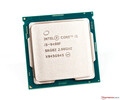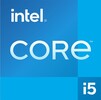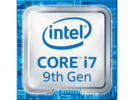Intel Core i5-9400F vs Intel Core i5-1245U vs Intel Core i7-9700
Intel Core i5-9400F
► remove from comparison
The Intel Core i5-9400F is a six-core desktop processor based on the Coffee Lake architecture introduced in October 2018 along with the flagship Intel Core i9-9900K. The processor clocks at 2.9-4.1 GHz and can process up to 6 threads simultaneously. The Intel Core i5-9400F is manufactured in the improved 14-nm process (14nm++).
Performance
Compared to the Intel Core i5-8400, the performance could only be increased slightly. Performance increases of up to 10 percent can be expected. Both processors (old and new) still do not offer hyperthreading. The performance increase therefore only adds up to small architecture improvements and a slightly higher basic and turbo clock rate. This CPU is suitable for everyday office use, which does not require large coolers due to the low waste heat. But games are also among the application areas, because in games the Intel Core i5-9400F clearly beats the Intel Core i3-9100F. Here the six cores are paying off in the meantime.
Graphics unit
The Intel Core i5-9400F is a processor without integrated graphics unit. If you value an iGPU, you should take a closer look at the Intel Core i5-9400, as it offers the entry level Intel UHD Graphics 630.
Power consumption
Intel puts the Thermal Design Power (TDP) at 65 watts. This means there is no need for large cooling systems, which also allows installation in very compact housings.
Intel Core i5-1245U
► remove from comparison
The Intel Core i5-1245U is a mid-range mobile CPU for thin and light laptops based on the Alder Lake architecture. It was announced in early 2022 and offers 2 performance cores (P-cores, Golden Cove architecture) and 8 efficient cores (E-cores, Gracemont architecture). The P-cores support Hyper-Threading leading to 12 supported threads when combined with the E-cores. The clock rate ranges from 1.6 to 4.4 GHz on the performance cluster and 1.2 to 3.3 GHz on the efficient cluster. The performance of the E-cores should be similar to old Skylake cores (compare to the Core i7-6700HQ). All cores can use up to 12 MB L3 cache. Compared to the i7-1265U (fastest U-series CPU at launch), the 1245U offers lower clock speeds, a slower iGPU, but the full "Enterprise" vPro management features. Compared to the P-series (28W) or H-series (45W), the 15W TDP may limit the sustained performance.
Performance
Thanks to the 10 cores, the multi-threaded performance should be clearly faster than the older quad-core Tiger Lake CPUs with 15 Watt (like the Intel Core i7-1160G7). The sustained performance will be limited by the TDP setting and thermals and therefore only short term loads. Thanks to the architectural improvements of the big Golden Cove cores, the single thread performance should be better than similar clocked Tiger Lake CPUs.
Features
The integrated memory controller supports various memory types up to DDR5-4800, DDR4-3200, LPDDR5-5200, and LPDDR4x-4267. The Thread Director (in hardware) can support the operating system to decide which thread to use on the performance or efficient cores for the best performance. For AI tasks, the CPU also integrates GNA 3.0 and DL Boost (via AVX2). Quick Sync in version 8 is the same as in the Rocket Lake CPUs and supports MPEG-2, AVC, VC-1 decode, JPEG, VP8 decode, VP9, HEVC, and AV1 decode in hardware. The CPU only supports PCIe 4.0 (x8 for a GPU and two x4 for SSDs).
The integrated graphics adapter is based on the Xe-architecture and offers 80 of the 96 EUs (Execution Units) operating at up to 1.2 GHz.
The CPU is rated at 15 W base power (TDP, PL1) and 55 W max. Turbo power (PL2) and the whole SoC is manufactured on a 10nm process at Intel, which is known as Intel 7.
Intel Core i7-9700
► remove from comparison
The Intel Core i7-9700 is a high end desktop processor based on the Coffee Lake architecture. It integrates 8 cores (no Hyperthreading therefore also 8 threads) clocked at 3 - 4.7 GHz. Compared to the similar named Core i7-9700K, the 9700 has no open multiplicator for easy overclocking, offers lower clock speeds and offers a reduced TDP.
Compared to the old Core i7-8700, the 9700 offers two more real cores but no Hyperthreading. Therefore, the performance gain is not that big - depending on the app. The single core performance was slightly improved thanks to the higher Turbo clocks. As a high end desktop CPU, the i7-9700 is well suited for demanding tasks and gaming.
The integrated Intel UHD Graphics 630 graphics card is clocked at up to 1.2 GHz and offers no advantage compared to previous generations. As it is a very low end GPU, only some low demanding games like Hearthstone can be played with it (see GPU page for benchmarks).
Intel specifies the TDP at 65 Watt (instead of the 95W of the faster models) and therefore the CPU wont need a high end desktop cooling system.
| Model | Intel Core i5-9400F | Intel Core i5-1245U | Intel Core i7-9700 | ||||||||||||||||||||||||||||||||||||||||||||||||||||||||||||||||||||||||||||||||||||||||||||||||||||||||||||||||||||||||
| Codename | Coffee Lake-R | Alder Lake-U | Coffee Lake-R | ||||||||||||||||||||||||||||||||||||||||||||||||||||||||||||||||||||||||||||||||||||||||||||||||||||||||||||||||||||||||
| Series | Intel Coffee Lake | Intel Alder Lake-M | Intel Coffee Lake | ||||||||||||||||||||||||||||||||||||||||||||||||||||||||||||||||||||||||||||||||||||||||||||||||||||||||||||||||||||||||
| Series: Coffee Lake Coffee Lake-R |
|
|
| ||||||||||||||||||||||||||||||||||||||||||||||||||||||||||||||||||||||||||||||||||||||||||||||||||||||||||||||||||||||||
| Clock | 2900 - 4100 MHz | 1200 - 4400 MHz | 3000 - 4700 MHz | ||||||||||||||||||||||||||||||||||||||||||||||||||||||||||||||||||||||||||||||||||||||||||||||||||||||||||||||||||||||||
| L1 Cache | 384 KB | 928 KB | 512 KB | ||||||||||||||||||||||||||||||||||||||||||||||||||||||||||||||||||||||||||||||||||||||||||||||||||||||||||||||||||||||||
| L2 Cache | 1.5 MB | 9.5 MB | 2 MB | ||||||||||||||||||||||||||||||||||||||||||||||||||||||||||||||||||||||||||||||||||||||||||||||||||||||||||||||||||||||||
| L3 Cache | 9 MB | 12 MB | 12 MB | ||||||||||||||||||||||||||||||||||||||||||||||||||||||||||||||||||||||||||||||||||||||||||||||||||||||||||||||||||||||||
| Cores / Threads | 6 / 6 | 10 / 12 | 8 / 8 | ||||||||||||||||||||||||||||||||||||||||||||||||||||||||||||||||||||||||||||||||||||||||||||||||||||||||||||||||||||||||
| TDP | 65 Watt | 15 Watt | 65 Watt | ||||||||||||||||||||||||||||||||||||||||||||||||||||||||||||||||||||||||||||||||||||||||||||||||||||||||||||||||||||||||
| Technology | 14 nm | 10 nm | 14++ nm | ||||||||||||||||||||||||||||||||||||||||||||||||||||||||||||||||||||||||||||||||||||||||||||||||||||||||||||||||||||||||
| Voltage | 100 V | ||||||||||||||||||||||||||||||||||||||||||||||||||||||||||||||||||||||||||||||||||||||||||||||||||||||||||||||||||||||||||
| Die Size | 149 mm2 | 178 mm2 | |||||||||||||||||||||||||||||||||||||||||||||||||||||||||||||||||||||||||||||||||||||||||||||||||||||||||||||||||||||||||
| Socket | LGA 1151-2 | BGA1744 | FCLGA1151 | ||||||||||||||||||||||||||||||||||||||||||||||||||||||||||||||||||||||||||||||||||||||||||||||||||||||||||||||||||||||||
| Features | Dual-Channel DDR4-2666 Memory Controller, AVX, AVX2, AES-NI, TSX, Quick Sync, Virtualization | DDR4-3200/LPDDR4x-4266/DDR5-4800/LPDDR5-5200 RAM, PCIe 4, Thr. Dir., DL B., GNA, vProe Ent., RPE, MMX, SSE, SSE2, SSE3, SSSE3, SSE4.1, SSE4.2, AVX, AVX2, BMI2, ABM, FMA, ADX, SMEP, SMAP, EIST, TM1, TM2, HT, Turbo, SST, AES-NI, RDRAND, RDSEED, SHA | Dual-Channel DDR4-2666 Memory Controller, HyperThreading, AVX, AVX2, AES-NI, TSX-NI, Quick Sync, Virtualization, vPro | ||||||||||||||||||||||||||||||||||||||||||||||||||||||||||||||||||||||||||||||||||||||||||||||||||||||||||||||||||||||||
| Architecture | x86 | x86 | x86 | ||||||||||||||||||||||||||||||||||||||||||||||||||||||||||||||||||||||||||||||||||||||||||||||||||||||||||||||||||||||||
| $182 U.S. | |||||||||||||||||||||||||||||||||||||||||||||||||||||||||||||||||||||||||||||||||||||||||||||||||||||||||||||||||||||||||||
| Announced | |||||||||||||||||||||||||||||||||||||||||||||||||||||||||||||||||||||||||||||||||||||||||||||||||||||||||||||||||||||||||||
| max. Temp. | 100 °C | 100 °C | |||||||||||||||||||||||||||||||||||||||||||||||||||||||||||||||||||||||||||||||||||||||||||||||||||||||||||||||||||||||||
| iGPU | Intel Iris Xe Graphics G7 80EUs ( - 1200 MHz) | Intel UHD Graphics 630 (350 - 1200 MHz) | |||||||||||||||||||||||||||||||||||||||||||||||||||||||||||||||||||||||||||||||||||||||||||||||||||||||||||||||||||||||||
| Manufacturer | ark.intel.com |
Benchmarks
Average Benchmarks Intel Core i5-9400F → 100% n=41
Average Benchmarks Intel Core i5-1245U → 132% n=41
Average Benchmarks Intel Core i7-9700 → 121% n=41
* Smaller numbers mean a higher performance
1 This benchmark is not used for the average calculation













